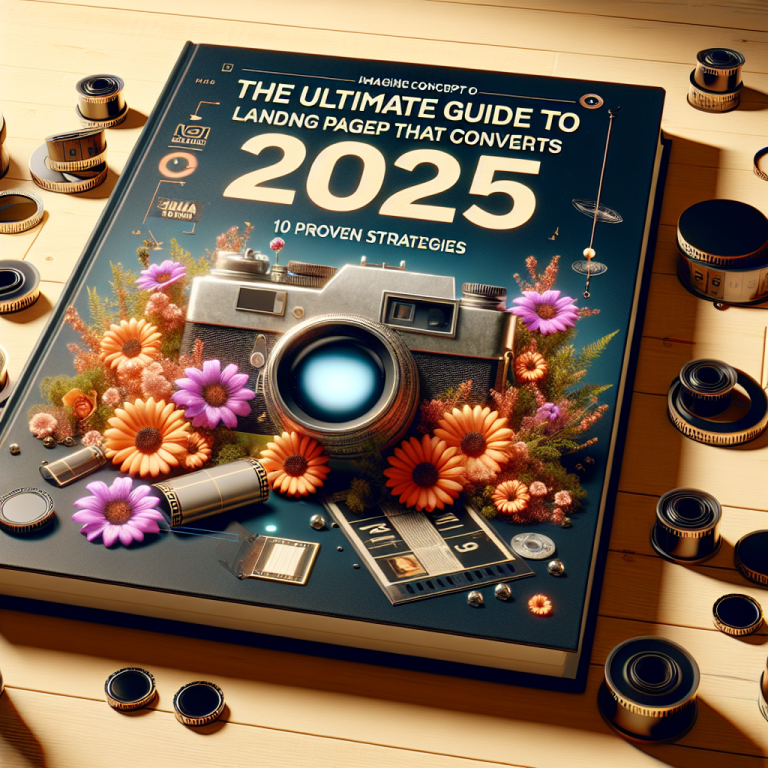The Simple Formula for Making Videos That Convert Views into Sales
Understanding Your Target Audience
Identifying Your Audience
First things first, if you want your video to convert views into sales, you absolutely have to know who you’re talking to. I remember when I first started making videos; I just assumed everyone would love what I created. Spoiler alert: they didn’t. I quickly learned that diving deep into the demographics and psychographics of my audience was essential. What do they enjoy? What problems are they facing?
To get a grip on your audience, consider conducting surveys or looking at your existing customer data. Understanding their preferences helps tailor your video content to resonate with them on a personal level.
One of the best discoveries in my journey was creating personas—detailed profiles of my ideal customers. This not only helped me speak their language but also shaped the way I approached my video content. Trust me, it makes a massive difference.
Creating Empathy
Once you know your audience, it’s time to build empathy. Everyday life can be rough, and tapping into the emotions of your audience is key. I remember a project where I shared a personal story that mirrored the challenges my audience faced. Connecting on that human level transformed viewer engagement.
Make your videos relatable. Share your struggles or stories that align with their experiences. People want to feel understood. When they do, they’re more likely to trust your brand and, ultimately, make a purchase.
Empathy fosters loyalty. When your audience sees that you genuinely understand their pain points and are there to help, they are much more likely to become repeat customers in the future. This is powerful stuff.
Using Feedback to Refine
Lastly, don’t forget to ask for feedback after you release a video. The insights you gain can be a goldmine. I’ve learned so much from my audience, and their suggestions have directly influenced my future content. Sometimes they point out aspects that didn’t even cross my mind!
Encourage comments, conduct polls, and listen to what your viewers have to say. This not only gives you ideas for future videos but also helps improve the existing ones. Making your audience feel a part of the process strengthens the community around your brand.
Remember, the goal is a two-way conversation. The more you listen and adapt, the better your videos will resonate with viewers, turning casual watchers into paying customers.
Crafting Engaging Storylines
Building a Narrative Structure
One of the coolest things I’ve learned is that storytelling is powerful. Every video needs a hook, a story arc, and a resolution. I can’t tell you how many videos I’ve watched that just dive right in without a compelling narrative. Boring! Your viewers need a reason to stick around.
Start with a captivating hook that grabs attention. Make them want to know what happens next. Then, build tension—show them the problems and struggles and lead them down a path that engages their emotions.
Finally, conclude with a solution or a call to action. This makes your message memorable and drives viewers toward the next step you want them to take, whether it’s subscribing, purchasing, or simply sharing.
Incorporating Visual Elements
Visuals play a massive role in storytelling. When I started applying visuals to my videos, I saw a huge uptick in engagement. Use graphics, b-roll footage, and animations judiciously. These elements can clarify complex concepts or simply make the video visually appealing.
People remember visual stories better than plain narratives. So sprinkle in imagery that embodies your brand and enhances your message. It doesn’t have to be over-the-top, but the right visuals can elevate your compelling story.
Ultimately, think like a filmmaker. Your videos should be a well-crafted experience that holds your audience’s hand through the content while making them feel something profoundly emotional and engaging.
Creating Relatable Characters
In every good story, there are characters that viewers can relate to. You want to create a persona that resonates with your audience. This could be you as the founder, a customer testimonial, or even an animated character. Heck, I’ve used my dog in videos before, and people ate it up!
Build these characters around your audience’s pain points and victories. When viewers see someone they identify with, they are more likely to connect emotionally with your message. It’s all about establishing that strong relationship.
Remember, people buy from those they know, like, and trust. So infusing your videos with relatable characters can bridge the emotional gap and turn views into sales.
Incorporating Strong CTAs
Building Clear Calls to Action
Alright, let’s get real here. It’s easy to create a great video, but if you don’t have a solid CTA, you’re missing out. A strong call to action directs viewers on what to do next. I learned this the hard way—my first few videos just ended without any direction, and guess what? My conversion rates tanked.
Be clear. If you want them to buy something, say it. If you want them to subscribe, tell them! Hold their hand and guide them through the next steps. Trust me; it makes a massive difference in conversion rates.
And make it appealing! Use language that creates a sense of urgency. Phrases like “limited time offer” or “don’t miss out” can push viewers to take action immediately. Your audience is always looking for motivation to make a purchase—it’s your job to provide that!
Positioning Your CTA Strategically
Location, location, location! You wouldn’t hide your storefront behind a bush, right? Same principle applies to CTAs in videos. I often place them strategically within the video rather than just at the end. This keeps the momentum going and reinforces the action I want viewers to take.
Don’t be afraid to include CTAs in multiple spots! Maybe at the introduction to hook their attention, in the middle to sustain engagement, and at the conclusion to drive home the final push. Experiment with placements and see what works best for your audience.
As you gather insights, adjust the timing and positioning based on what yields the best results. Use analytics to study viewer drops, and revamp CTAs accordingly. It’s all about optimization!
Testing Your CTAs
Finally, you can never skip the testing phase. Think of your CTAs as living creatures—they need nurturing and experimentation to thrive. Play around with wording, visuals, and placements. A/B testing has been my best friend in this arena.
Gather data and let it guide your improvements. Sometimes all it takes is a small tweak in phrasing to make a world of difference in conversions. Be open-minded, and don’t be afraid to pivot if something isn’t working.
And remember to share the results! This is a journey you’re on with your audience. When they see how you’re adjusting based on feedback and testing, it builds trust, making them even more inclined to hand over their hard-earned cash.
Optimizing for SEO
Choosing the Right Keywords
SEO is like the magical fairy dust that helps your video get seen online. In my earlier days, I struggled with this, thinking that just creating awesome content was enough. But no, my friends. Keyword research plays a crucial role in visibility.
Start by researching what keywords your target audience is searching for. Once you have that down, integrate these keywords naturally into your video title, description, and tags. Don’t overdo it—just let it flow organically.
Using tools like Google Keyword Planner or Ubersuggest can help you find relevant terms. The goal is to intertwine your keywords with engaging content so the video appears in searches, driving traffic straight to it!
Crafting Captivating Titles and Descriptions
After getting your keywords down, it’s time for the fun part—crafting an eye-catching title and description. I love this step because it gives you a chance to reel in your audience with something snappy.
Your title should be enticing yet include those valuable keywords we just talked about. It’s like bait for your audience—make it irresistible! And don’t leave out descriptions; they need attention too. This is your chance to elaborate on the video content and pull in those keywords again.
Also, consider including timestamps in your descriptions for easy navigation. It’s a fantastic user experience touch that keeps people coming back for more. Who doesn’t love a friendly video that saves them time?
Promoting Your Video
Once your video is out, don’t just sit back and twiddle your thumbs. Promotion is key! Shout it from the rooftops—share on social media, embed it on your website, and send it out via newsletters. I usually have a content calendar set up to keep track of my promotion schedule.
Don’t be afraid to reach out to influencers or partner with others for broader exposure. Collaborations can supercharge your views and validate your brand in the eyes of new audiences!
And remember to engage! Respond to comments on your video; it creates community and encourages more interaction. The more buzz you create, the better your chance of converting views into sales!
Analyzing and Iterating
Using Analytics Tools
Alright, folks, this is where the magic of data comes in! Once your video is live, it’s crucial to dive into the analytics. I would say it’s almost like having a cheat sheet to what works and what doesn’t. Using platforms like YouTube Analytics has transformed my approach to video content.
Pay attention to metrics like view duration, click-through rate, and engagement statistics. These tell you how viewers are interacting with your content. When you spot trends, latch onto what’s working and run with it.
Remember, analytics can be overwhelming if you let it. Focus on a few key metrics at first, and as you grow comfortable, you can expand your tracking approach. Ultimately, being data-driven is what will help refine your strategy.
Gathering Viewer Feedback
Don’t just rely on data; engage with your audience too. Polls and surveys can provide incredibly valuable qualitative insights. How are they feeling about your content? What do they wish to see more of? I’ve received feedback that turned whole video concepts on their heads.
Listen to your viewers; they’re the ones consuming your content. When they share their thoughts, it’s like gold. I often keep an eye on comments for fresh ideas and ways to enhance future videos.
Creating a community where viewers feel valued encourages repeat viewership and deeper connections with your brand. It’s a win-win!
Iterating Based on Data
Based on the data and feedback you gather, don’t be afraid to iterate. I regularly go back to my old videos and refine them based on newly acquired knowledge. Sometimes it’s subtle tweaks to the video or entirely new edits—whatever it takes to improve performance.
Testing different formats, video lengths, or even topics can keep your channel fresh and engaging. Your audience’s preferences will evolve, so it’s vital to evolve with them. I can’t tell you how many times I’ve recalibrated my content for greater engagement.
Iterating isn’t a sign of weakness; it’s a sign of growth. Every change is an opportunity to connect deeper and improve your sales conversions. Embrace it!
Frequently Asked Questions
What makes a video convert into sales?
A video converts into sales by engaging the target audience through storytelling, clear CTAs, and effective SEO. It’s about creating a connection with viewers and presenting solutions that meet their needs.
How should I identify my target audience?
You can identify your target audience through market research, surveys, and analytics. Create audience personas to visualize their preferences and pain points, thus honing in on what content resonates with them.
How important are CTAs in videos?
CTAs are crucial as they guide viewers on what actions to take next. A strong, clear call to action can significantly boost engagement and conversion rates, making it essential to include them strategically.
What role do visuals play in my videos?
Visuals enhance storytelling, capture attention, and keep viewers engaged. They can simplify complex ideas and create a more memorable viewing experience, contributing to higher retention rates and conversions.
How can I use analytics to improve my video strategy?
Analytics helps track various performance metrics like watch time, click-through rates, and engagement. By analyzing these insights, you can iterate and refine your content strategy, ensuring what you create continues to resonate with your audience.









